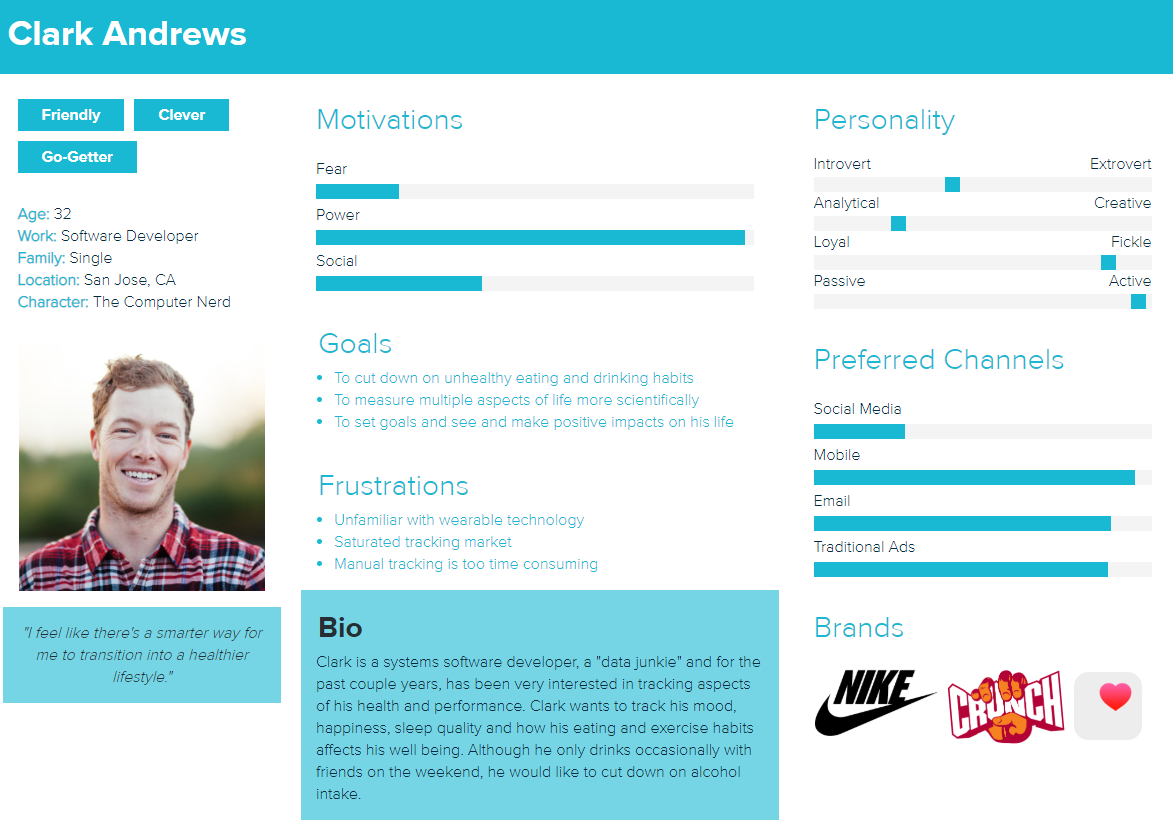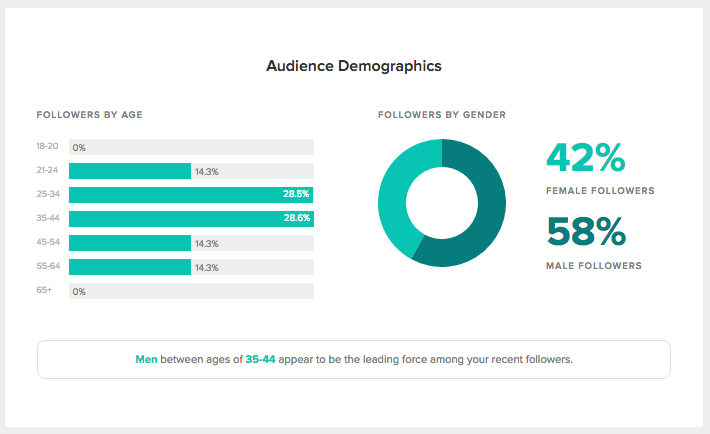How to use social media personas to boost brand engagement

Table of Contents
Do you know what your ideal customer on social media looks like – literally?
In day and age where people crave personalization from businesses online, it pays to get as specific as possible when it comes to defining your target audience.
But when you’re targeting hundreds or thousands of followers, how can you possibly guarantee that your message is on point?
Welcome the world of social media personas.
Marketing personas put a proverbial face to your customer base, allowing you to better define and market to your most profitable customers.
And thanks to the sheer amount of data we can gather via social media, doing so is arguably easier than ever.
Why marketers need social media personas
For starters, let’s quickly break down what personas are.
Social media personas are fictional representations of your ideal customers. Taking into account factors such as demographics, desires and pain points, personas paint a picture of the individuals you’re trying to sell to.
In other words, a profile of your perfect customer.
Maybe you’re trying to reach the millennial crowd. Perhaps you’re marketing toward baby boomers. Either way, creating a persona can help you hone in on a more focused, actionable social strategy.
How so? Consider the benefits of social media personas below.
Improve your content strategy
From finding your brand voice to publishing relevant pieces, social media personas help you tap into content that speaks to different members of your audience.
For example, Denny’s is a brand that’s infamous for it’s meme-heavy Instagram and bizarre Twitter. These feeds are favorites of millennials who are hungry for humor rather than traditional restaurant marketing fare.
However, the brand’s Facebook page takes a totally different approach. Publishing “safer,” more traditional content, Denny’s Facebook speaks to an older crowd and their posts still get a ton of love.
https://www.facebook.com/dennys/photos/a.385196608140/10156356631613141/?type=3&theater
The brand is clearly targeting different social media personas based on their platforms rather than taking a one-size-fits-all approach. This sort of segmentation allows them to speak to multiple customer bases and interact with these audiences using the content styles and platforms they prefer.
Run more compelling ad campaigns
It’s no secret that ad campaigns on Facebook and Instagram are killing it right now for brands concerned about organic reach.
And most of these ads’ success boils down to granular audience data.
By having your social media personas defined, you can zero in on ad targeting that’s tailored for your brand’s best customers.
When ad platforms allow brands to target based on everything from age and location to related interests, having personas handy makes for more compelling ads that speak to specific wants and needs.
Tap into a profitable target audience
No matter who your target audience might be, competition in the social space is undoubtedly fierce.
That’s why it pays to tap into niche markets and customers sooner rather than later.
Instead of taking a “trickle down” approach, brands should consider going after specific sections of their audience rather than blindly chasing anyone and everyone.
And your personas can teach you exactly who those customers are and where they hang out.
Brands like Overtone absolutely crush it with their color-crazy customer base rather than presenting themselves as a generic beauty brand. Their loud feed featuring primarily millennial women is no accident, nor is the high level of engagement the brand gets on any given post.
What does a social media persona look like, anyway?
Although there is no “right” way for a persona to look, a rule of thumb is that the more specific you can define your social media personas, the better.
Here are some sample personas from a sporting brand looking to create an audience-aligned social strategy:

Although these personas are a solid starting point, they could definitely go much more in-depth.
Consider how many brands quite literally craft narratives for their social media personas. Highlighting specifics such as fictional biographies, motivations and personality traits, such personas are akin to real flesh-and-blood people. For example, Xtensio offers blank templates which highlight what a more “complete” persona looks like:

And here’s what the “finished product” of a customer persona look like:

Excessive?
Not at all.
Again, any given audience is incredibly nuanced. Having these points highlighted makes it much easier not only to craft appropriate brand messages but also attract customers that are likely to convert.
And if nothing else, creating social media personas is a smart exercise to ensure that your social strategy isn’t just copying your competition’s.
Regardless of how in-depth you decide to get, below are some baseline metrics and points to consider when coming up with your social media personas:
- Age
- Location
- Gender
- Income/spending power
- Pain points/frustrations
- Personality traits
- Goals
- Objections
- Brands they support
Seems like a lot to take in, right? At a glance, sure.
The good news? Everything from audience metrics to qualitative data such as your customers’ frustrations is all readily available via social media – read on to find out how to tap into this wealth of information.
How to define your social media personas
You might already have a big-picture idea of what your personas might look like.
And hey, that’s a good start.
However, defining your personas means spending some time both looking at data and picking your customers’ brains.
Dig into your social data
If you want to break down your demographics by the numbers, look no further than your social data.
For example, Sprout’s social analytics suite provides a comprehensive look at how your audience stacks up based on many of the metrics highlighted above. Aggregating data from your social presence across platforms, there’s no second-guessing what your personas should look like.

Sprout has a number of other features that can give you the insight you need to fill in the gaps of your persona profiles. Social monitoring & listening let you tap into what your audience is interested, possibly even uncovering shared interests and concerns you wouldn’t have immediately connected with your target market. Identifying your top-performing posts and the best times to publish can help you figure out how your audience prefers to engage on social. You can also mine your social data via Facebook Insights, Twitter and LinkedIn. Looking at the individual profiles of brand advocates and customers can likewise illustrate what your personas might look like.
Look at your non-social analytics
Social media isn’t the only place to gather information for your social media personas.
For example, you should understand on-site behaviors that could ultimately influence your social strategy. This data includes:
- Shopping data
- CRM data
- Google Analytics
For example, you might notice that a particular product or whitepaper is driving the bulk of your traffic. Ask yourself: what aspects of your customers’ wants or needs are your top-performers speaking to? These can be valuable data points for your persona profiles.
Similarly, you can also figure out which social sites are most relevant to your personas. Rather than spread yourself thin, you can focus your future efforts based on where your customers are currently hanging out.

More sources of social audience data
If you’re looking for more inspiration on finding audience data and improving your insights, read up on these resources:
- Social media demographics to inform your brand’s strategy
- How to define and reach your target audience on social media
- How to find your target audience on Instagram
Ask plenty of questions
Analytics aren’t the be-all, end-all of your social media personas.
Never neglect the simple act of asking questions concerning what your customers’ wants or needs might be. Whether it’s through a survey, poll or a simple social post, your audience’s responses provide valuable insight into their struggles. There’s a reason why so many brands make asking questions a staple of their content strategies.
What do you look for? #SproutChat pic.twitter.com/zcXkvLgVgP
— Sprout Social (@SproutSocial) September 26, 2018
Turning your social media personas into action
Alright, so let’s say your personas are squared away.
Now, what do you do with all of this data?
Fair question. Given what it takes to come up with a social media persona, it’s obviously a priority to turn all of that legwork into action.
For starters, here are some starting points for what to do once you’ve established your social media personas.
Segment your audience
While going through the process of creating personas, you’ll likely learn that your customers have many “faces.”
This is totally fine. Few businesses have a single, uniform persona they’re marketing toward.
Segmenting your audience by persona can influence everything from your content calendar to your ad strategies. For example, Facebook ads allow you to create ad sets based on variations of your audience. Meanwhile, you’ll want to make sure that you fill your content calendar with posts that don’t overlook any part of your customer base.

Adapt your brand voice
Once you know your social media personas, it’s much easier to adapt your brand voice and have more authentic conversations with customers.
After all, brands rely on different tones of voice. Based on your demographics, knowing which tone to take seems much less daunting.

Want to crack some jokes? Present yourself as a helping hand?
Go for it. Brand voice influences your social captions, ad copy and anything else you might use to speak to customers
Brands like Chewy have mastered a distinct, playful brand voice for their pet-friendly audience.
However, they also know how to put on a serious face without being totally gloom and doom.
Finding your voice based on your social media personas might take some time, but it’s a critical piece of making your presence stand out from the crowd.
Tweak your content strategy
Finally, consider how social personas are instrumental to your content strategy.
Ask yourself: are you producing content that speaks to your personas’ motivations and frustrations? How are you helping your customers reach their goals?
Whether it’s your next blog post or live video, you need to have a pulse on what your personas might be buzzing about today to stay topical.
This also means that fine-tuning your personas is an ongoing process. As you track trends and continue to ask questions, social listening and attention to detail will constantly keep you in the loop with what your personas want.
What do your brand’s social personas look like?
The takeaway here? The more you know about your target audience, the better.
Creating social media personas allows you to reflect on everything you need to know about your ideal customers. This ultimately allows you to uncover a more meaningful social strategy and produce messages that resonate with your prospects.
And with so much data at our fingertips via social media and tools like Sprout, defining your personas is easier than ever. Get started by reviewing the latest social media demographics.

Share